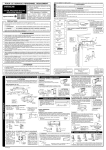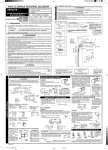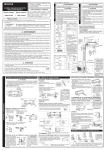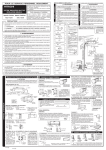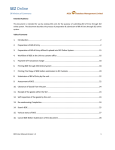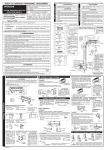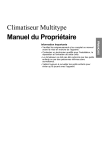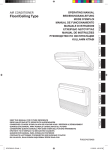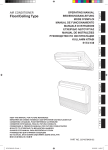Download User manual - Australian Leisure Facilities Association
Transcript
P. 39 Appendix A: Manual for Using the CBA and EIA Tool User guide to the Sport and Recreation Facilities Cost Benefit and Economic Assessment Model The objective of the Sport and Recreation Facilities Cost Benefit and Economic Assessment Model is to assist Sport and Recreation Victoria in undertaking a Cost-Benefit Assessment (CBA) and/or an Economic Impact Assessment (EIA) associated with the development of a new facility or an extension/ upgrade of an existing community sport and recreation facility. The model is designed to operate in both 2003 and 2007 versions of Microsoft Excel. 7 different tabs The model contains 7 tabs. A description of each tab is outlined on the cover tab of the model. As a user the most important tabs are the input and output tabs. The only tab into which information should be entered is the tab labelled “input”. The results of the cost benefit analysis are in the “CBA output”. The results of the economic impact assessment are contained across three tabs “EIA output”, “Chart1 – Time series”, and “Chart2 EIA Snapshot”. Where to start In order to use this model, information on the project must be collected. Whilst most of this is likely to be contained in the funding application or a feasibility study for the project, there may be cases in which further information will need to be collected. Appendix B contains the type of questions needing to be answered in order to run the model. Assuming all of the information is collected the user should then enter the relevant information into the tab labelled “input”. Only manipulate/ enter information into cells shaded in grey. Filling out “General Information” 1. Type of facility Indoor recreation represents indoor dry centre developments such as leisure centres, gymnasiums, indoor courts etc Aquatic includes aquatic centres and pools, and refers to all indoor, outdoor and combined indoor and outdoor aquatic centres Outdoor field category includes sporting fields, recreation reserves, etc Multi-type category allows the assessment of a facility with multiple sections e.g. swimming pools plus indoor tennis plus indoor gym etc. The tool allows for a development with up to 15 sections. This category should only be selected in instances CBA and EIA of Community Sport and Recreation Infrastructure / Victoria P. 40 where information on expected visitation and admission fees by section are known. If this “multitype” category is selected then the option to choose number and description of sections appears. 2. Within which LGA? Select LGA the facility is located in. 3. Population in Catchment In completing this, consider the catchment area of the facility - is it a local neighbourhood, is it the municipality or a broader region - and enter the population of this catchment area. If the LGA is the catchment area the user can simply click the “LGA is catchment” button to fill in the catchment population. 4. Estimated Market Share This should be a percentage between 0% and 100%. In completing this consider what other competitors currently serve the same catchment area, and reflect what proportion of the catchment area population the facility can roughly call its „market‟. The „market size‟ is then determined by estimated market share by population in catchment. Filling out “Visitation” 1. Expected Number of Annual Visitations This is the number of annual visitations once the development is completed. If the “facility type” entered was either “Indoor Recreation” or “Aquatic” then this section will allow the user to use benchmarks for calculating visitations either based on catchment populations or based on the size (in square metres) of the development. Of course, the user can always opt to enter values manually. If the square metres benchmark is to be used the size of the new development in square metres must be entered. Expected annual visitations are broken down into working (roughly 15-64) and non-working age. 2. Existing number of visitations This is the number of visitations prior to the development. If the development is a new facility the existing visitations will be zero. 3. New visitations This simply is the difference between the existing number of annual visitations and annual visitations after the development is completed. No entry is required in this field. 4. New Visitations (by those at least visiting once a week) This is the number of new visitations that is likely to be related to a participant that visits at least once a week i.e. new visitations associated with regular participants. If information on this is not available the “Estimate” button can be used to enter an estimated value based on benchmarks from the ERASS. 5. Expected Additional Participants CBA and EIA of Community Sport and Recreation Infrastructure / Victoria P. 41 This refers to total new participants that are expected at the facility after the development is completed. This is also to be broken down by working and non-working age. 6. Expected Additional Participants, Previously not Physically Active, and Visit At Least Once Per Week This should be an estimate of total new participants at the facility after the development is complete, that did not engage in regular physical activity prior to coming to this facility and are expected to visit this new facility on a regular basis (at least once a week). The aim of this is to estimate total new participation in regular physical activity induced by the development. 7. Expected Number of New Volunteers This is the expected number of new volunteers in full time equivalent terms expected at the facility after the new development is operational. 8. Average Travel Time to Facility (in minutes), both ways This is the average travel time taken by a participant to get to the facility and return. In answering this, consider where the participants are likely to be coming from and their method of transport. Note that this refers to time in minutes for total travel to and from the facility. Filling out “Admission Fees” In this section the user can choose to enter the (a) admission fees broken down by working age and non working age (child/ pension fees), or (b) total expected revenue from new visitations resulting from the development (i.e. increase in total admission revenue as a result of new development). Do not enter values in both (a) and (b). If the “facility type” entered was either “Indoor Recreation” or “Aquatic” then working age admission fee can be estimated using benchmarks by clicking the “estimate” button. If “Multi-type” was selected then the admission fee for each section should be entered. Filling out “Costs” This section requires information on the costs of construction and operations of the new development. 1. Dates and Lifespan Enter the estimated construction commencement and completion dates and the operation commencement date in the dd/mm/yyyy format. The variable Years will automatically calculate the length of the construction period. The Lifespan should be an estimate of the life of the development. 2. Construction Cost Provide an estimated annual breakdown of the construction costs associated with the development. The construction costs should reflect all costs associated with construction including labour and materials costs. 3. Annual (Marginal) Recurrent Costs This is the marginal increase in the total operating cost as a result of the new development. This costs should include any increase in operating costs, which should CBA and EIA of Community Sport and Recreation Infrastructure / Victoria P. 42 cover costs such as labour costs, professional services fees, utilities, insurance, depreciation associated with development, purchase of supplies and advertising costs etc) 4. Total Additional (Full Time Equivalent) Employment at Facility This is the expected number of new employees in full time equivalent terms expected at the facility after the new development is operational. Filling out “Energy and Water Savings” In the context of cost benefit assessment, the energy savings is not measured as a net societal benefit as the development in most cases is likely to alter energy and water usage by changing overall visitation. Thus increased efficiency is measured in relation to a hypothetical base case which represents the development as it is, less the investment in ESD initiatives. So under this base case the energy savings would not come about. So whilst this does not show as a net benefit in the cost benefit analysis results, the energy and water efficiencies are measured by comparison of performance measures between the project case and the hypothetical base case. If the user deems the energy and water savings to be a benefit of the project, the user then needs to enter an estimated reduction in the annual energy bill and water bill in comparison to the hypothetical base case. Outputs There are four output tabs: 1. CBA output 2. EIA Output 3. Chart1 – Timeseries 4. Chart2 - EIA Snapshot CBA Output The results of the CBA are in the tab labelled “CBA Output”. Each of the terms in the summary table are explained in Appendix D. Notably the table presents two scenarios – “Project Case” and “Hypothetical Base Case”. The first column (Project Case) simply reports on the performance of the project being evaluated. If the user responded “Yes” to the question “Is energy and water savings a benefit for this project?” in the input tab, the values presented in the second column (Hypothetical Base Case) will be different to the “project case”. In particular the “PV Costs” would be higher by the amount of energy and water cost saved per annum. Thus the “Hypothetical Base Case” presents an alternative scenario had the investment used materials without the consideration of environmentally sustainable design, and illustrates the potentially poorer CBA performance measures that may have resulted. CBA and EIA of Community Sport and Recreation Infrastructure / Victoria P. 43 A second table in the “CBA Output” tab summarises the benefits into categories of health, economic, social and environmental benefits, based on a broad classification of the different types of measurable benefits into these headings. An example of interpreting the results, the following is a description of the hypothetical tables presented below. The following table contains the results of a cost benefit analysis for this project. The present value of the benefits amount to $650, and the present value of costs $100. The project has a positive net benefit of $550, yields a benefit to cost ratio of 6.5 and an internal rate of return of 15%. Had the environmentally sustainable design initiatives been forgone, the higher projects costs would potentially have resulted in a poorer benefit to cost ratio of 4.3 and lower internal rate of return of 10%. The health and social benefits are the most significant with a present value of $250 each. The economic benefits are $150. An estimated value of environmental savings associated with the project in comparison to a potential alternative form of development where environmentally sustainable design initiatives had been forgone is $50. CBA Performance Measures Project Case Hypothetical Base Case 1 Discount Rate 6% 6% PV Costs $100 $150 PV Benefits $650 $650 Net Benefit $550 $500 Benefit to Cost Ratio 6.5 4.3 IRR 15% 10% Estimate Present Value of Benefits by Type Health $250 Economic $150 Social $250 Environmental $50 EIA Output The “EIA Output” allows the user to evaluate the economic impacts associated with the construction phase or operation phase of the project, or sum of the two. The analysis presents outputs for “output”, “value added” or “employment” (terms explained in Appendix D). There are two key summary tables presented at the bottom of this tab. The first provides an economic impact assessment for a given year (and for the chosen component of the project – CBA and EIA of Community Sport and Recreation Infrastructure / Victoria P. 44 operation, construction or both), and the second gives a total economic impact assessment across all years. The latter would be used where a number of years were to be considered rather than one (e.g. in the instance where say the total construction period was being assessed). An example of interpreting the results, the following is a description of the hypothetical tables presented below. The first table below displays the economic impacts of the projects construction expenditure (note this would depend upon whether the user had chosen operation, construction or both) for 2006. The construction expenditure in 2006 of $100 had a flow on impact of $150, thus resulting in a total impact of $250 on economic output. The project employed 5 full time equivalent workers, and supported a further 7 full time equivalent jobs via flow on impacts. Finally the total impact on value added amounted to $70. The second table displays the impacts of the entire construction period. The total construction expenditure amounted to $1,500 over the XXXXX years. The flow on impacts associated with this expenditure is $2,000, resulting in a total economic impact on output of $3,500. The total impact on value added was $1,100 and the project supported a 100 total (direct and indirect) full time equivalent jobs. Chart 1 – Time series This chart illustrates the annual time series of direct and indirect (or flow on) impacts associated with the chosen component of the project (i.e. operation, construction) and for the chosen economic variable (i.e. output, employment or value added). CBA and EIA of Community Sport and Recreation Infrastructure / Victoria P. 45 Chart 2 - EIA Snapshot This chart graphically presents the first summary table presented in the “EIA Output” tab. It is a snap shot of the direct, indirect and total impacts associated with the chosen component of the project (i.e. operation, construction), a chosen economic variable (i.e. output, employment or value added) and for a chosen year. Appendix B: Inputs Required to Operate the Tool Questions relating to inputs required for the Sport and Recreation Facilities Cost Benefit and Economic Assessment Model 1. Which of the following types does the project fall into, Indoor Recreation, Aquatic, or Outdoor Field? If the project has multiple types of development you may wish to classify it as “Multi-Type”. 2. How many square metres is the total built area of the facility now? How many square metres was it prior to being developed? 3. Number of people in catchment? 4. What is the estimated market share within this catchment? (The response should consider what other competitors are there serving the same catchment area, and reflect what proportion of the catchment area population the facility can roughly call its „market‟– e.g. 100%, 50%, 25%) 5. Total annual visits per year and total number of visitors post development of facility. If possible can you estimate what proportion of these visits and visitors are working age and non working age. 6. Total annual visits per year and total number of visitors prior to development of facility. If possible can you estimate what proportion of these visits and visitors are working age and non working age? 7. Roughly what percentage of the new visitors engaged in little or no physically activity previously (answer should be estimate between 0% and 100%), again broken down by working age and non working age? 8. What is the average travel time that visitors would spend in getting to the facility? 9. What is the admission fee to the facility? or else what is the increase in annual revenue from admissions from prior to and post development? 10. Can you please provide construction timing (start date, end date), and provide a breakdown of the construction spend by year. How many full time equivalent construction workers were roughly employed by year of construction phase? 11. What date did operations commence? 12. What is the average annual recurrent cost in running the project? Has there been any efforts to measure the improved energy efficiency as a result of development? If so what is the reduction in energy and water bills annually? If not what would you expect the reduction roughly to be? 13. What is the expected lifespan of the development? 14. How many more employees were hired as a result of the development (in full time equivalent numbers)? 15. How many new full time equivalent volunteers have commenced since the development?








